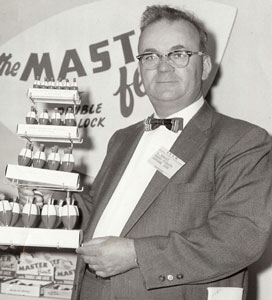1/25/2012
A Master of Invention
Chris Beytes

Ludwig “Lou” Schmidt was a machinist and craftsman who loved nothing better than building a better mousetrap. Says his grandson, Rick Hughes, “He really enjoyed machines and figuring out how to do things better. We called him a tinkerer—he just loved to figure out how to make things. Somebody would ask, ‘Isn’t there a better way to do this?’ and he’d figure out a better way.”
German born, Lou emigrated to the United States in 1923 when he was 19 years old, settling in Chicago and landing a job with International Harvester.
But Lou was also an avid fisherman and he loved to wet his line in rural Montague, Michigan, on the state’s west side.
It was around the time of the Second World War that Lou decided to buy some property around Montague. He learned that the hardware store on the town’s block-long main street was for sale. Being tool and hardware minded, he decided that the hardware business was the perfect new career for him.
Naturally, he also stocked some fishing equipment. One day, sometime in the late 1940s, a gentleman came in to purchase a fishing outfit. Lou set him up with a rod and reel and the appropriate tackle—except for a bobber. The fellow declined to buy one, saying, “They slip up and down the line too much, and that defeats the whole purpose.” Bobbers at that time, you see, had only one hook for grasping the string, which proved to be inadequate for the purpose. Lou noted this and, being a born tinkerer, he decided to craft an improvement.
In this post-war period, plastics were a booming new industry. Lou set up an injection-molding machine in his hardware store and began molding and gluing bobbers with an improved two-hook design, testing each one in a tank of water. He dubbed them “Master Float,” with a “double line lock,” and he called his new plastics company “Master Products Company.” This was 1949.
Lou manufactured and sold his bobbers with some success, which brought him to the attention of a neighbor, Harry Weesies, owner of Weesies Brothers Greenhouse. Harry dropped in one day with a request. Could Lou make him some plant labels out of that new-fangled plastic? Apparently, Harry was fed up with wooden labels because they rot and are hard to write on.
A stubborn German, Lou apparently didn’t jump on the idea right away—he didn’t think there could possibly be a market for plastic plant labels, especially considering the tooling costs associated with making them.
But Harry, an equally stubborn Dutchman, persisted, as did some other plantsmen. Finally convinced otherwise, Lou invested in tooling and began to injection-mold plant labels one at a time in the back of the hardware store. Rick recalls helping out as a kid, hand-trimming the excess plastic flash from the edge of each label with a knife. “It was my grandmother’s job, but sometimes they’d ask me to help out,” he says.
The new plastic labels had a textured matte finish that made them easy to write on, hence his name for them, “E-Z Rite” plant tags. Growers started ordering them, first by the hundreds and then by the thousands. When a large grower from Georgia ordered 20,000, Lou hired his first employee, Irma Kollaritch (who stayed with the company for 40 years until her retirement) and the business took off.
Lou soon added printing capabilities, first in just black ink and then in full color. In the 1960s, they added pictures to the tags, and Lou’s son Dick came into the family business. The 1970s saw the advent of plastic sheet extrusion and the addition of grandson Rick to the business. In 1979, Master Products was changed to MasterTag, the name also given to their redesigned line of modern picture labels, still the most popular label style used today.
Today, MasterTag makes hundreds of millions of full-color tags and signage in a wide range of shapes, sold around the world. They’re expanding into digital technology (via their new consumer website
mygardeninsider.com) as a way to provide cultural information beyond what can be printed on the label.
“The thought now of injection-molding labels one at a time and trimming them one at a time is almost incomprehensible to us now,” says Rick, MasterTag’s owner and president.
And to think: It all started with a tinkerer, a hardware store and a bobber.
GT